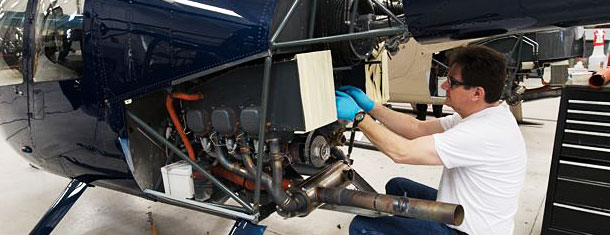
I thought that I would kick off this new column by trying to clear some very muddy water relating to the overhaul periods for the Robinson R22 and R44 series helicopters and their costs.
There are two distinct requirements for the overhaul of this helicopter: When it has been operated for 2200hrs on the hour meter (for the R22 this is engine running time and for the R44 it equates to flight time). This is a "things wear out" overhaul. When it has been in service for 12 years, regardless of hours run/flown. This is a "things rot" (environmental overhaul).
When the helicopter has operated for 2200 hours it is completely overhauled, all components are zero timed and those items that do have a critical life are replaced with new and so when the helicopter is returned to service it will have a full 2200 hours and 12 years before the next overhaul.
When the helicopter has operated for 2200 hours it is completely overhauled, all components are zero timed and those items that do have a critical life are replaced with new and so when the helicopter is returned to service it will have a full 2200 hours and 12 years before the next overhaul.
A helicopter that has been in service for 12 years but has not run/flown the full 2200 hrs only requires a 12 year overhaul, the components are not overhauled but items with a critical life of 12 years (main rotor and tail rotor blades) are replaced with new and when the helicopter is returned to service will have 12 years and/or the time remaining to 2200hrs, which ever comes first.
Still clear as mud! Here is an example: Your helicopter has 1000hrs on the hour meter but is 12 years old, what has to be done?
Well your helicopter is only due a 12 year overhaul and not a 2200 hrs overhaul. Very simply (I cannot list the complete requirement) it will be completely disassembled, the frames and skid gear will be striped, inspected, crack checked and re painted. All greased bearings, seals, flexible hoses etc. will be replaced. The main and tail rotor blades will be replaced with new, but the components will only be inspected and have their seals changed (they are not overhauled). The engine can remain in service without an overhaul lAW CAA Airworthiness Notices. After reassembly your helicopter will go back into service with 12 years and 1200 hrs left to run/fly (the remaining time to 2200 hrs).
Now the main question you will be asking is what is the cost difference?
An approximate would be that a 12-year overhaul should be about half the cost of a 2200hr overhaul. A caveat to this is of course "You reap what you sow" If your helicopter is left outside to rot and maintenance in the form of tender loving care is compromised, the cost will be affected upwards.
In my experience there is never a saving to be made by skimping, it will always end up costing you more. ("A stitch in time saves nine").
I am always amazed that owners and potential owners of the Robinson product think that it is only the Robinson helicopter which is subjected to a calendar overhaul; when in fact most helicopter types have a similar environmental overhaul requirement but at a much greater cost.
If we use the Bell 206 as an example of the importance of the Pre-Flight Check and adherence to the manufacturer's requirements and ADs (Airworthiness Directives) then the pilot should be made aware of blade tape and the cause and effect of de-bonded tape. Pilots would therefore need to know what to do should such an event (tape de-bonding) occur.
The pre-flight should also cover tail rotor blade tip blocks, and the witness marks on the 'B' nuts on the engine F.C.U. (Flight Control Unit) and Governor pipes, all of which have been the subject of A.Ds
There was, moreover, the tragic case of the death of the three occupants in a Hughes 269 helicopter that broke up in flight after a failure of a rear undercarriage cluster. The bereaved father, a well-known personality within the industry, strongly believes that had the inspection of this area, (which has been the subject of an A.D. for some years) been included in the pilot's pre-flight inspection, his son and the other occupants would still be alive today. I totally agree with him.
Every helicopter type has a number of areas that require special attention when conducting a pre-flight inspection, and these are probably not found in the standard published procedures. I have to say that in my experience there is an appalling lack of standardisation and product knowledge when it comes to the technical/operational aspects of flying, and this
goes right back to the instructors. I am not suggesting that we are trying to make engineers out of pilots, but there must be an acceptable base line.
It is a fact, that faced with a problem in flight, the pilot with a good technical understanding of the helicopter they are flying, is less likely to react in a manner that changes a benign indication in the cockpit into a life threatening situation.
An example of this is the helicopter pilot who, while flying his helicopter, saw his engine RPM needle fall back to the stop, although there was no change in engine noise or torque he assumed this was an engine failure and, not considering it might be an instrument malfunction, put the helicopter into autorotation. Getting the flare wrong at the bottom of the autorotation he damaged the helicopter (although he and the passenger were unhurt) entirely un-necessarily as the problem had actually been within the instrument itself and not in the engine.
The idea behind these articles is to get you thinking about the types of helicopters you fly and maybe take for granted. If any of these articles prompt a question, please do e-mail me.
I spend a great deal of my time trying to improve flight safety within the helicopter industry so I would like to make H.C.G.B. members a special offer:
If any helicopter pilots out there would like to spend some time with me going through a pre-flight inspection as well as other relevant information on their helicopter type then please contact the H.C.G.B. so that we can arrange an event accordingly.
